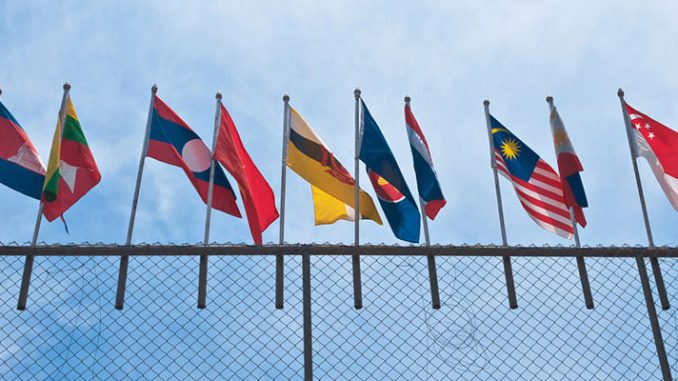
As 2015, the date set for accomplishing an integrated regional community, looms near, for members of the Association of Southeast Asian Nations (ASEAN), there is much debate and discussion on how much has been accomplished. The date for announcing the single ASEAN Community, 31 December 2015, still leaves an additional calendar year for ASEAN members that might be rushing to meet commitments made under various ASEAN agreements. Yet already, the reality on the ground indicates that 2015 will be another signpost in ASEAN’s quest for regional integration.
Since its establishment in August 1967, ASEAN envisioned “a Southeast Asian region of peace, freedom and prosperity for their peoples”. Thirty years on, the ASEAN Vision 2020 statement in 1997 highlighted the links between the different spheres of regional cooperation – political, economic and social. Then in 2003, the 9th ASEAN Summit charted the current course for regional integration, through individual blueprints for the ASEAN Political-Security Community (APSC), the ASEAN Economic Community (AEC), and the ASEAN Socio-Cultural Community (ASCC). These together constitute peace and prosperity for the people of an integrated region. The 12th ASEAN Summit in 2007 shortened the date for achieving Vision 2020 goals to 2015.

Striving for a political and security community is ASEAN’s raison d’être. The APSC has worked to prevent or minimise conflict in the region while keeping the major powers engaged in Southeast Asia through processes such as the ASEAN Regional Forum (ARF), the ASEAN Plus Three, and, starting from 2005, the East Asia Summit (EAS); and establishing a rules-based foundation for inter-state relations through instruments such as the Treaty of Amity and Cooperation (TAC) in Southeast Asia and the ASEAN Charter. Yet, the failure in 2012 to reach a common position regarding the activities of claimant states in the South China Sea highlighs a reality of tensions; strains between the national interests of member states and the priority to be accorded to broader regional interests. But in 2014, under the all-encompassing theme of “Moving forward in unity towards a peaceful and prosperous Community”, ASEAN member states have issued stronger-worded statements on the South China Sea, and have been engaging in multi-layered diplomacy that strikes a balance between regional commitments to accomplish, together with China, a Code of Conduct of Parties in the South China Sea, and the significant bilateral relations that some ASEAN members have with China.

ASEAN was one of the first developing regions to adopt an outward-oriented development strategy. The region’s free trade area is now essentially in place although domestic acceptance and enforcement of regional commitments is an ongoing topic of debate, fuelling scepticism of ASEAN’s ability to achieve the AEC by 2015. ASEAN’s external economic relations have met with greater success; several FTAs with countries throughout the world, including those with China and India, are in place. The AEC aims to create a unified market and production base by 2015 via a free flow of goods, services, foreign direct investment (FDI), skilled labour and a freer flow of capital. Its Blueprint has been described as a “highly ambitious” programme of economic cooperation, aspiring to make ASEAN economic cooperation the most comprehensive and substantive regional cooperation programme in the developing world. Despite obvious challenges, AEC implementation has been the most visible area of regional integration, mainly due to the quantitative (and quantifiable) targets of the AEC. AEC benefits are seen in terms of lower transaction costs, reduced prices and increased consumer choices, all of which are important to the people in ASEAN member countries, the intended beneficiaries of closer economic integration.
The ASCC’s focus is on improving the lives of ASEAN’s peoples by ensuring the welfare and protection of citizens, including access to healthcare, education and employment; addressing common challenges to health and to the environment; and, regional cooperation aimed at building capacities towards development and progress. The ASCC priorities are thus inter-related with issues relevant to countries’ economic competitiveness. Together — natural disasters, environmental pollution, the loss of biodiversity, and haze — all have implications for economic development, as do the need for meeting the demands of a knowledge economy.
[pullquote]The most visible signs of ASEAN integration are in the area of economic cooperation[/pullquote]Scepticism notwithstanding, ASEAN does show nascent signs of integration. The most visible are in the area of economic cooperation. Over the 1998-2010 period, the share of intra-ASEAN trade rose steadily, reaching around 25% of ASEAN’s total trade in 2003. The proportion of intra-ASEAN trade has since remained relatively stable at that figure, despite the global financial crisis in 2008-9 bringing a decline in total ASEAN trade. The prevailing proportion of intra-ASEAN trade appears to be consistent with the region’s current economic structure. Of ASEAN’s newer member states, Myanmar remains the most dependent on intra-regional trade, while Vietnam is the least dependent. Singapore, Malaysia, Indonesia and Thailand have the largest shares of the intra-regional trade, followed by the Philippines and Vietnam. Thus, the more open economies in ASEAN are, then they also have the largest share of intra-regional trade.The foreign direct investment (FDI) inflow statistics show a different aspect of ASEAN’s integration story. Intra-ASEAN FDI rose from 11.1% to 20.1% of total FDI inflows into the region over 2003-08. The uptrend was interrupted during the 2008-9 global financial crisis, which also saw overall FDI inflows drop. However, intra-regional FDI flows are recovering as the region emerges from the crisis. Singapore tops the list for share of FDI inflows with a 46.6% share, perhaps reflecting its position as a key regional hub. These ASEAN statistics suggest that the region is integrating gradually at least from an economic perspective. Perhaps this is as quick as the region can progress with its numerous challenges. Lessons from the EU’s recent experience in dealing with issues of integration have left ASEAN wary about steaming ahead with integration without first doing the groundwork; building political will and support from the people. Analysts have observed that ASEAN’s integration into the global economy has fared better, as gleaned from ASEAN’s external economic relations. Among ASEAN’s five major trading partners – China, EU, Japan, the United States, and South Korea – only China’s share of trade with ASEAN has increased over time to overtake the rest. But China’s share of the FDI inflow into ASEAN is relatively small, and the EU, Japan and the US remain the top three sources of FDI into the region.
The biggest challenge, however, is that results are not immediately visible to the man on the street. Perceptions persist that ASEAN is an elite (and elitist) organisation, more for high politics and diplomacy rather than the day-to-day issues that affect most of the 620 million people in Southeast Asia.
ASEAN has tried to address this gap by prioritising people-centred regional initiatives and in more attempts to engage with the civil society. Much more needs to be done before the average citizen can identify with the sense of regional belonging that ASEAN seeks. An encouraging development is the nascent sense of community developing among the younger generation in ASEAN member states. A survey carried out in 2007 among undergraduate students in the region showed that about 75% of the respondents felt they were citizens of ASEAN, although at individual country-levels there was considerable diversity in attitudes towards the ASEAN processes, ranging from the ambivalent and sceptical (in Singapore and Myanmar) to strong enthusiasm (in Cambodia, Laos and Vietnam). The survey is being updated currently, to compare how attitudes have changed (or not) since 2007. The findings will be relevant to an ASEAN pre-occupied with examining regional identity and its efforts for community building on the eve of its first comprehensive integration milestone.
Ultimately, the success of ASEAN’s integration will be measured by whether the citizens of ASEAN nations feel a sense of participation in the various regional processes. This is the crux of the work-in-progress nature of regional cooperation.
Moe Thuzar
Moe Thuzar is Lead Researcher for Socio-Cultural Affairs at the ASEAN Studies Center, Singapore’s Institute of Southeast Asian Studies
Kyoto Review of Southeast Asia (Issue 16), Young Academics Voice, December 2014
Catch up with more great YAV articles from Kyoto Review of Southeast Asia—




